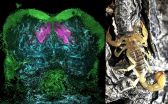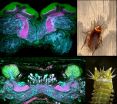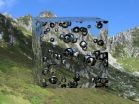(Press-News.org) Whether you're cramming for an exam or just trying to remember where you put your car keys, learning and memory are critical functions that we constantly employ in daily life.
It turns out that the structure and function of brain centers responsible for learning and memory in a wide range of invertebrate species may possibly share the same fundamental characteristics, according to a new study published in the journal Current Biology and performed by University of Arizona neuroscientists Nicholas Strausfeld, Regents' Professor in the Department of Neuroscience, part of the UA's School of Mind, Brain and Behavior, and Gabriella Wolff.
The brain centers in question are paired, lobed structures first discovered in insects and known as mushroom bodies. These centers occur in the forebrains of arthropods, as well as in marine worms and flatworms.
Because the commonalities between mushroom bodies in different species are so striking, there long has been a debate about whether these structures evolved independently or whether they derive from a common ancestor. Strausfeld's and Wolff's analysis revealed a ground pattern organization that is common to mushroom bodies in all of the investigated species, suggesting its inheritance from an ancient ancestor, possibly 600 million years in the past.
"This ground pattern of mushroom bodies is ubiquitous across a broad range of species," said Wolff, a graduate student in the Neuroscience Graduate Interdisciplinary Program. "If we wanted to emulate a learning and memory center in an artificial intelligence or a robot, this is where we would start."
Strausfeld and Wolff looked at both the neuroanatomy and chemical composition of mushroom bodies in numerous species belonging to two major groups of invertebrates: Ecdysozoa, which includes insects, crustaceans and other arthropods such as scorpions and horseshoe crabs; and Lophotrochozoa, which includes mollusks, flatworms and segmented worms.
Using a variety of chemical staining techniques, Strausfeld and Wolff were able to study and compare the neuroanatomy of different species in great detail. Not only were the characteristics of individual mushroom body neurons the same across species, their organization among each other was the same as well. The researchers found that parallel bundles of neuronal fibers in the mushroom bodies in each species are arranged in similarly structured, orthogonal networks typical of learning circuits.
Next, the team analyzed protein expression in mushroom bodies. It found that the abundance of three proteins -- called DC0, Leo and CaMKII -- was conserved in the mushroom bodies across these invertebrate groups. Previous behavioral studies have shown that these proteins are necessary for learning and memory, and their genetic sequences are almost exactly the same in fruit flies and rats.
Remarkably, these same proteins also are thought to be critical for learning and memory in humans, and are implicated in neurological disorders such as Alzheimer's disease, Down syndrome and Angelman syndrome.
After the study on invertebrate brains, Strausfeld and Wolff will embark on investigating vertebrates such as rats, birds, reptiles, amphibians and fish.
"We hope to find out whether or not a similar ground pattern of organization occurs across the vertebrates, and whether that pattern also includes these highly abundant proteins," Strausfeld said. "The candidate that might possess this ground pattern is the hippocampus, which is crucial for memory of place, among other things.
"People may recoil at the idea that their brains share commonalities with arthropods and other invertebrates. The fact of the matter is that the organizational principles are the same. This should be of great interest to biomedical researchers."
According to Strausfeld, confirmation of this shared ground pattern in the vertebrate hippocampus would suggest that it originated from a very ancient common ancestor likely to have lived about 600 million years ago just before the Cambrian explosion, a relatively short period when most major animal phyla emerged.
This means it is possible that brain structures responsible for learning and memory in nearly all animals that possess them -- including humans, but with the possible exception of mollusks -- may have originated from one ancestor and have since undergone divergent evolution into centers of various complexity.
Next time you feel like swatting a fly, you might want to think twice.
"The correspondence across disparate groups of animals is extraordinary," Strausfeld said. "It's almost too good to be true."
INFORMATION:
The abstract of the paper, "Genealogical Correspondence of Mushroom Bodies across Invertebrate Phyla," is available online at http://www.cell.com/current-biology/abstract/S0960-9822(14)01358-X
ST. LOUIS - Saint Louis University research findings published in the December issue of Antimicrobial Agents and Chemotherapy report a family of molecules known as nucleotidyltransferase superfamily (NTS) enzyme inhibitors are promising candidates for new herpes virus treatments.
The findings could lead to new treatment options for herpes that patients can use in conjunction with or instead of currently approved anti-viral medications like Acyclovir. Researcher Lynda A. Morrison Ph.D., professor of Molecular Microbiology and Immunology at Saint Louis University, likened ...
Why are older people at higher risk for developing cancer? Prevailing opinion holds that, over time, your body's cells accumulate DNA damage and that eventually this damage catches up with the body in a way that causes cancer. A University of Colorado Cancer Center study published today in the journal Aging shows that this prevailing opinion is incomplete. In addition to DNA damage, cancer depends on the slow degradation of tissue that surrounds cancer cells, something that naturally comes with aging.
"It's really all about natural selection and survival of the fittest," ...
Illinois is the most critical hub in the network of U.S. domestic food transfers, according to a new study by Megan Konar, an assistant professor of civil and environmental engineering, and colleagues at the University of Illinois at Urbana-Champaign. The study was published in the journal Environmental Science and Technology.
Much like the national airport network in which O'Hare International Airport is a major hub, Illinois plays the most central role in distributing food across the U.S. According to the report, the U.S. food network moves more than 400 million tons ...
Doctors and nurses are traditionally thought to be the primary caretakers of patients in a typical hospital setting. But according to a study at the burn center intensive care unit at Loyola University Health System, three physicians, a social worker and a dietitian were documented as the most central communicators of the patient clinical team.
David Shoham, PhD, and colleagues were published in the American Burn Association's Journal of Burn Care & Research. Shoham is an associate professor in the Department of Public Health Sciences of Loyola University Chicago Stritch ...
Chicago, December 17, 2014--A poll of the Russian public, conducted by The Associated Press-NORC Center for Public Affairs Research, was released today. The poll, which includes a nationally representative in-person survey of 2,008 Russian adults taken between November 22 and December 7, 2014, found that President Vladimir Putin is extremely popular. Few say the economy is in good condition and most say that sanctions are hurting the Russian economy. Despite economic woes, most Russians believe their country is headed in the right direction. Most respondents are also optimistic ...
WASHINGTON, D.C., December 18, 2014 -- Uncork a bottle of champagne, and as the pressure of the liquid is abruptly removed, bubbles immediately form and then rapidly begin the process of "coarsening," in which larger bubbles grow at the expense of smaller ones.
This fundamental nonequilibrium phenomenon is known as "Ostwald ripening," and though it is most familiar for its role in bubbly beverages, it is also seen in a wide range of scientific systems including spin systems, foams and metallic alloys.
On a much larger scale, Ostwald ripening can be observed in a power-generating ...
Cilia, the cell's tails and antennas, are among the most important biological structures. They line our windpipe and sweep away all the junk we inhale; they help us see, smell and reproduce. When a mutation disrupts the function or structure of cilia, the effects on the human body are devastating and sometimes lethal.
The challenge in diagnosing, studying and treating these genetic disorders, called ciliopathies, is the small size of cilia -- about 500-times thinner than a piece of paper. It's been difficult to examine them in molecular detail until now.
Professor ...
COLUMBIA, Mo. - A new study from University of Missouri and Virginia Tech researchers is challenging accepted ideas about how ancient soft-bodied organisms become part of the fossil record. Findings suggest that bacteria involved in the decay of those organisms play an active role in how fossils are formed--often in a matter of just a few tens to hundreds of years. Understanding the relationship between decay and fossilization will inform future study and help researchers interpret fossils in a new way.
"The vast majority of the fossil record is composed of bones and ...
New Rochelle, NY, December 18, 2014--Internet addiction is an impulse-control problem marked by an inability to inhibit Internet use, which can adversely affect a person's life, including their health and interpersonal relationships. The prevalence of Internet addiction varies among regions around the world, as shown by data from more than 89,000 individuals in 31 countries analyzed for a study published in Cyberpsychology, Behavior, and Social Networking, a peer-reviewed journal from Mary Ann Liebert, Inc., publishers. The article is available free on the Cyberpsychology, ...
Health care systems and providers are not attuned to older adults' malnutrition risk, and ignoring malnutrition exacts a toll on hospitals, patients, and payers, according to the latest issue of the What's Hot newsletter from The Gerontological Society of America (GSA).
Under the title "Aging Policy: Preventing and Treating Malnutrition to Improve Health and Reduce Costs," the new installment points out that aging is a risk factor for malnutrition and highlights opportunities to improve nutrition awareness, interventions, and policy priorities.
Support for the publication ...





